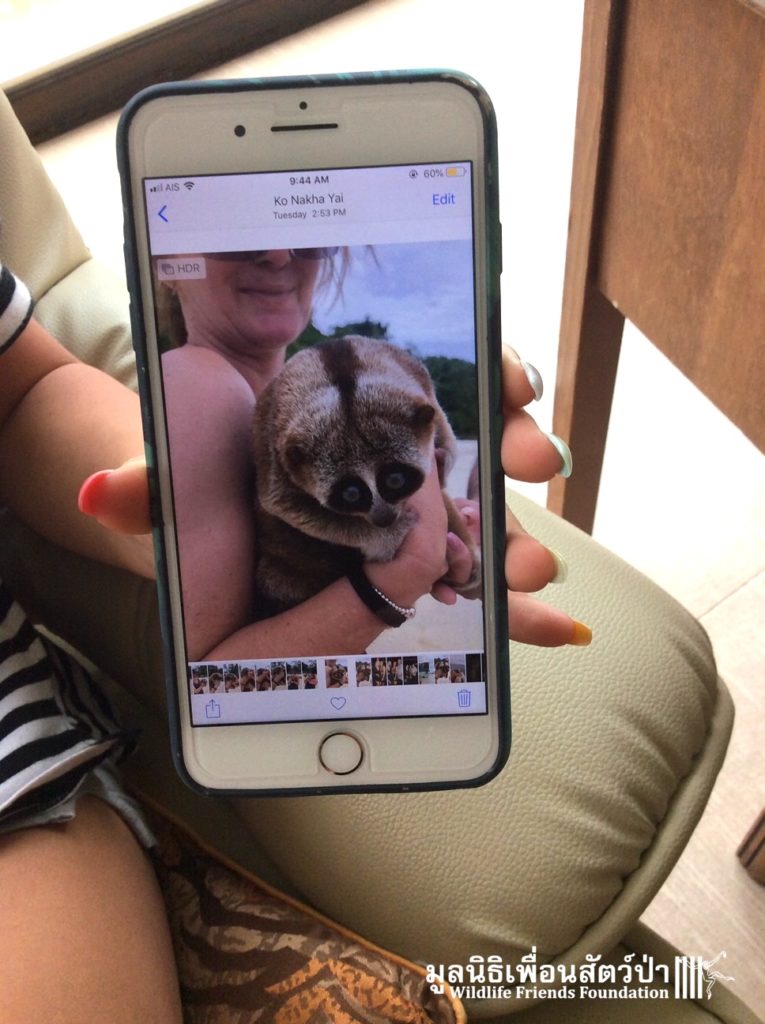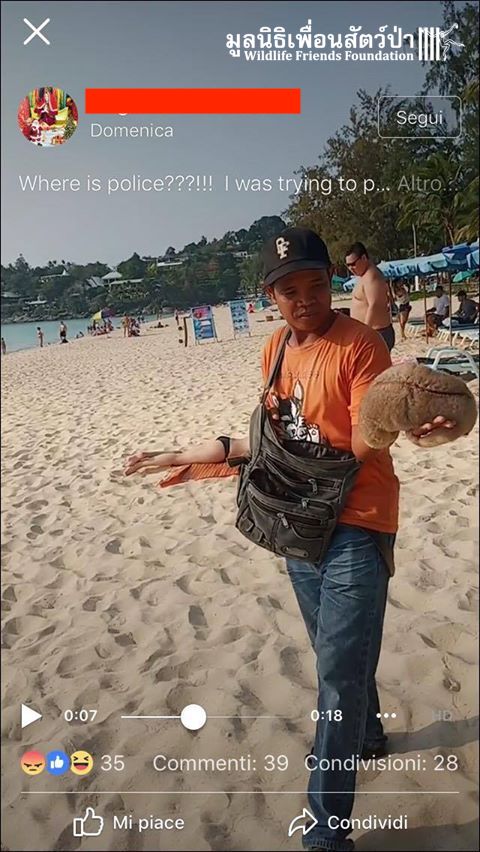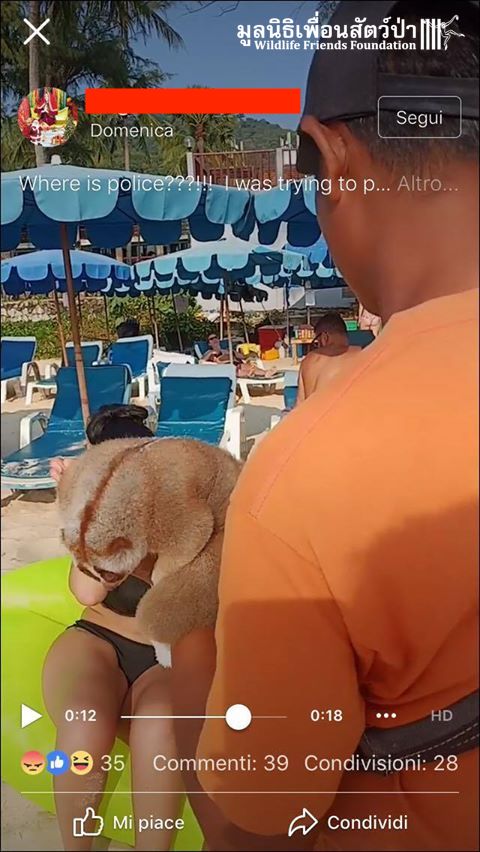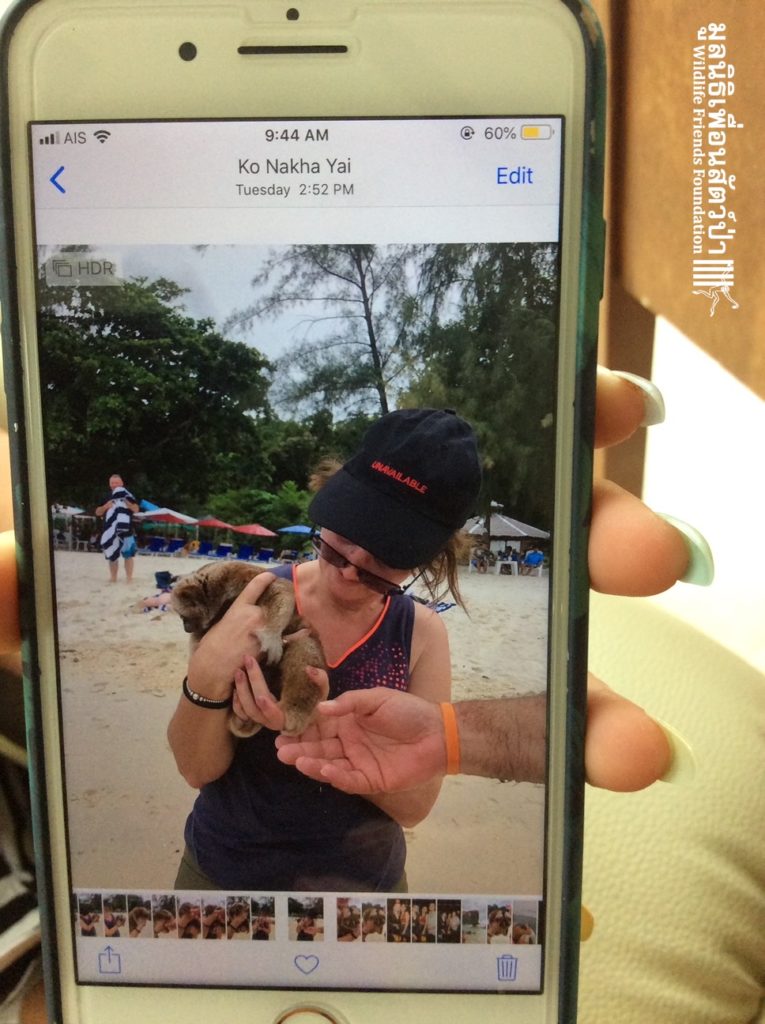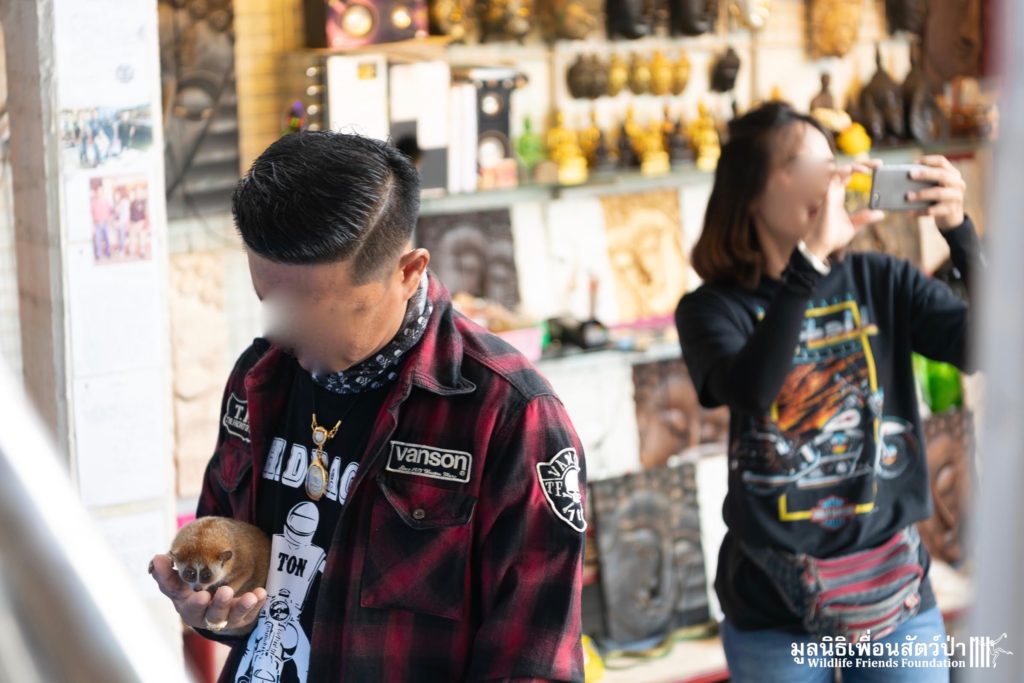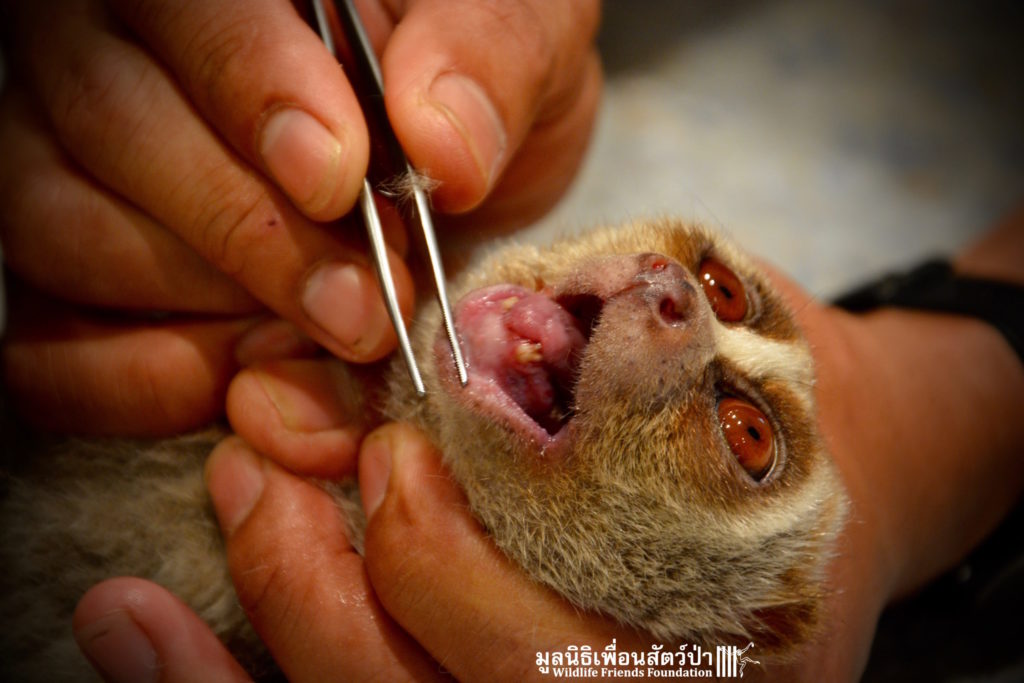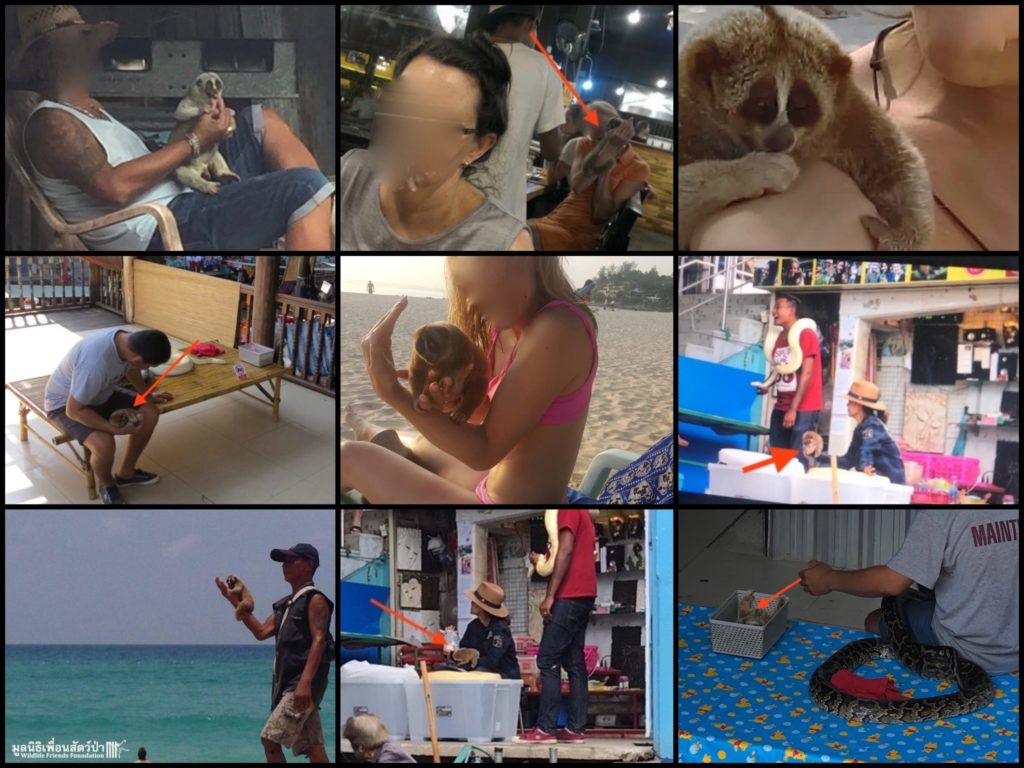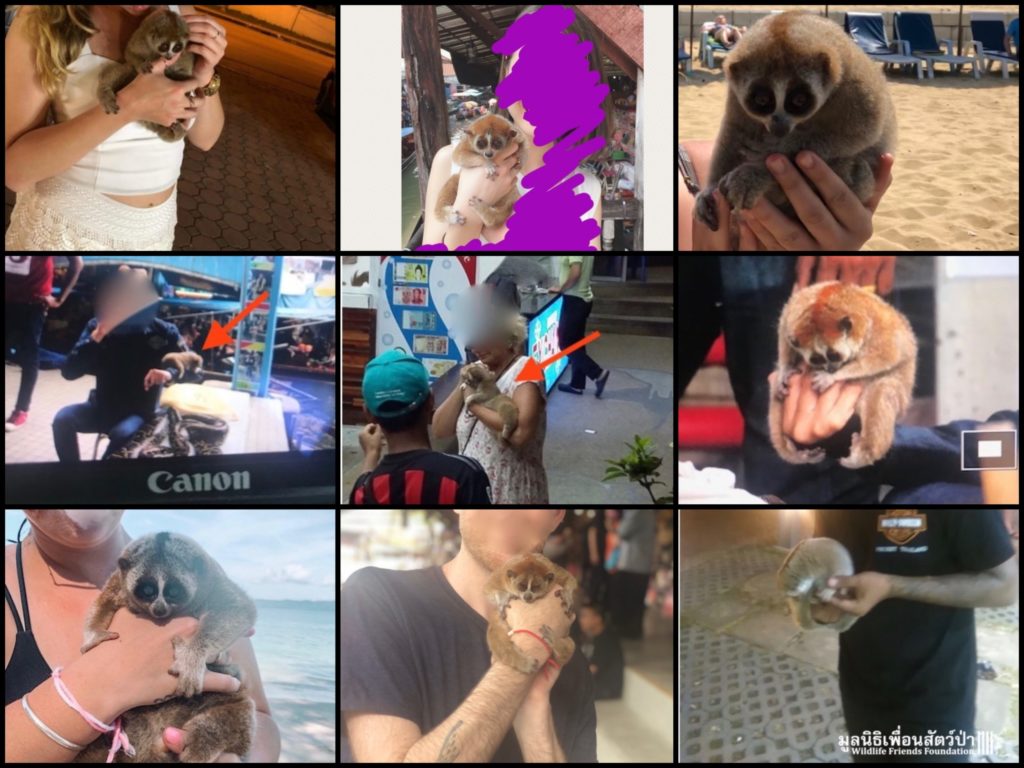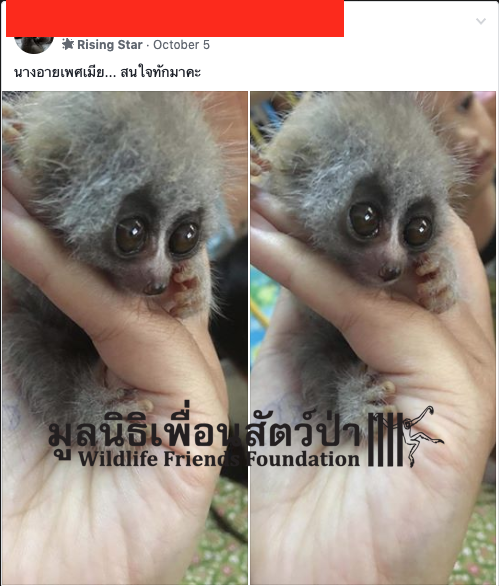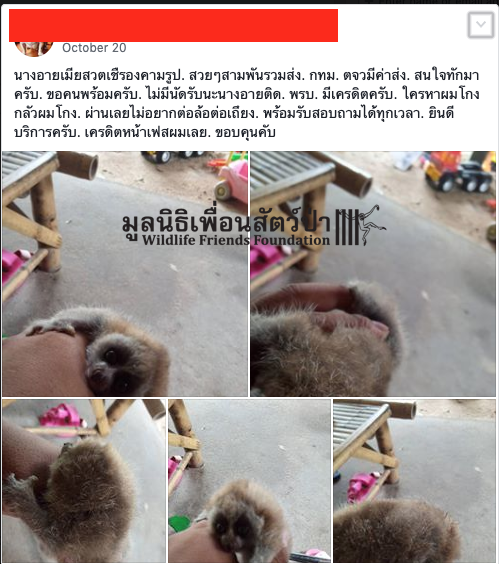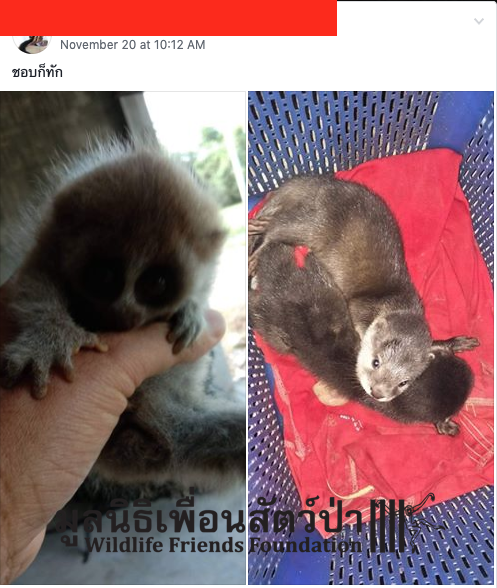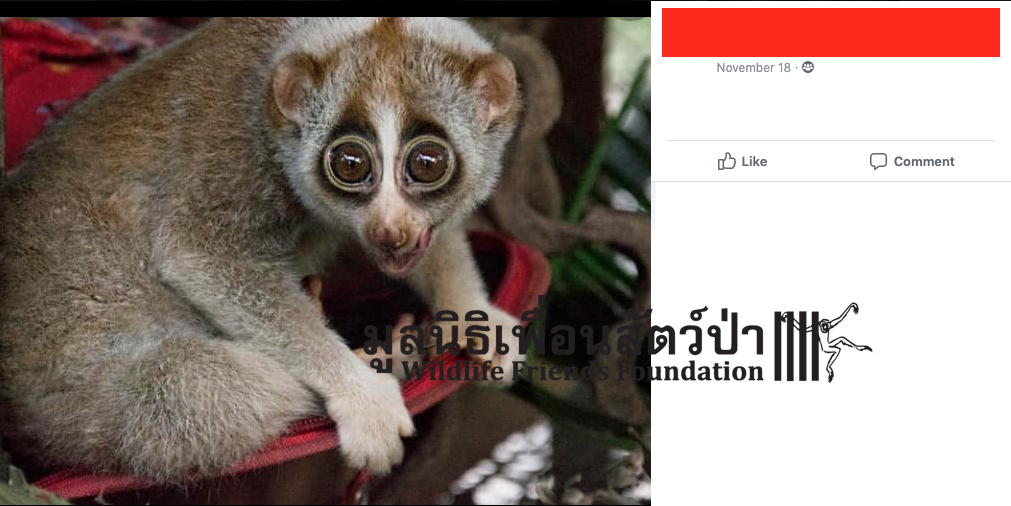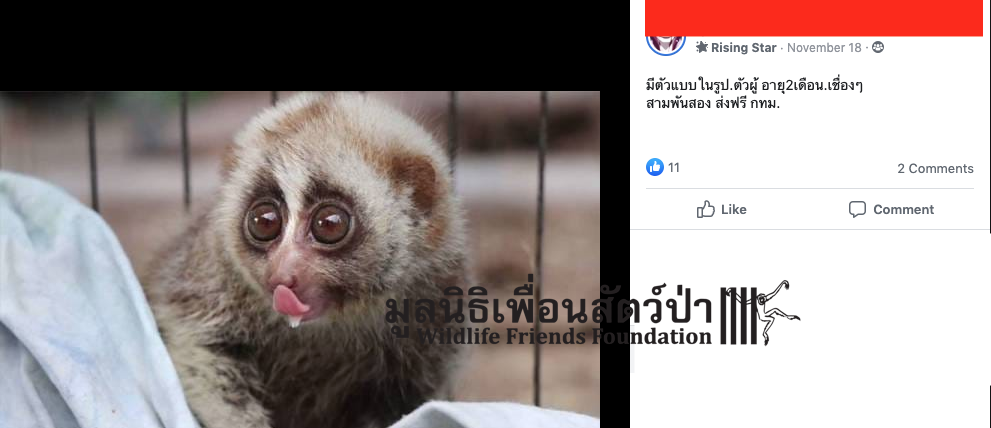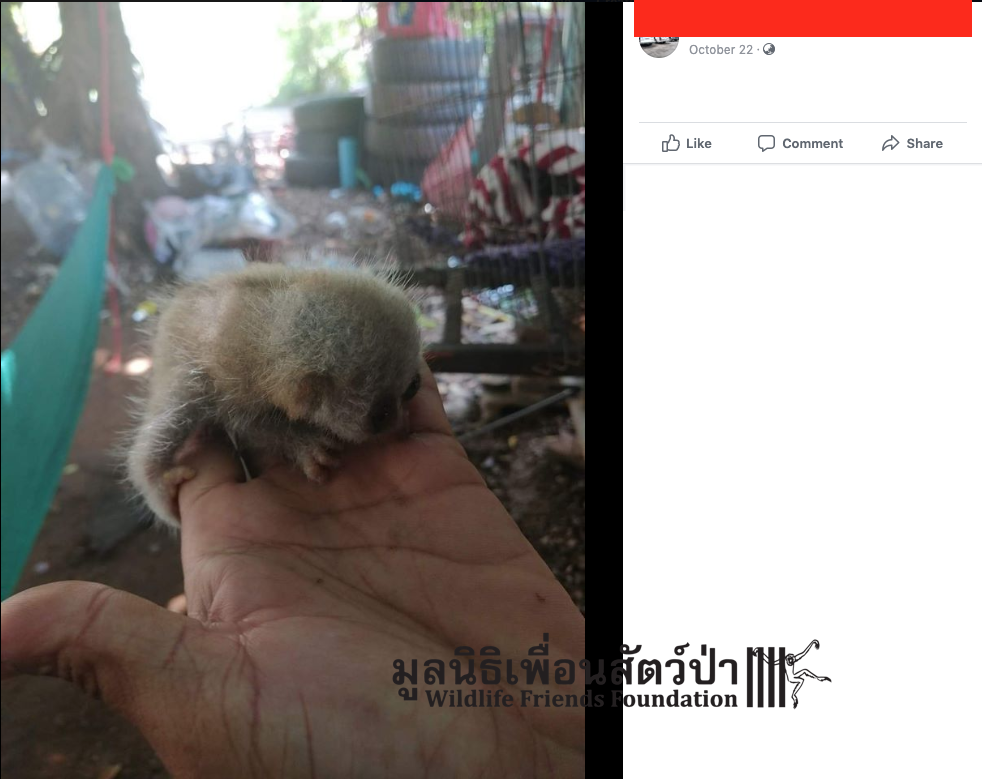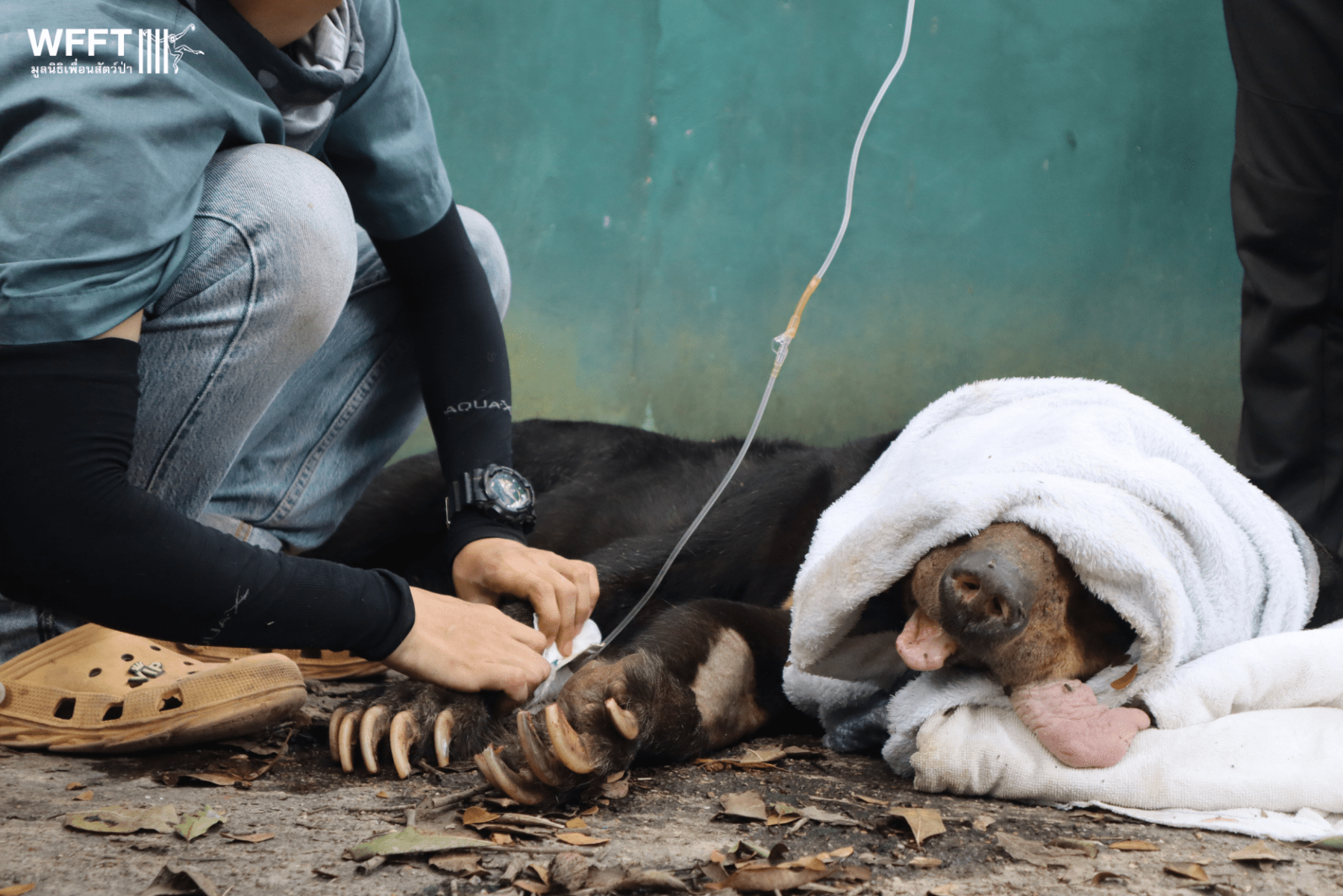A few days ago, Malayan Sun Bear Dodo was sedated for his bi-annual veterinary treatment, during which our team conducted a routine health check.
WFFT’s Slow Loris Photo-prop Campaign
(สำหรับภาษาไทยเลื่อนอ่านข้างล่าง)
We are starting a campaign against the cruel and illegal use of slow lorises as tourist photo-props in some of Thailand’s popular beach resorts.
Each week concerned members of the public contact WFFT about lorises being illegally used as photo-props. Photographs are sent to us from people asking us to help save these poor animals. The most common areas to see this cruel practice are at Damnoen Floating Markets in Ratchaburi, Chaweng Beach in Koh Samui and Kata and Karon Beaches in Phuket.
The sad reality for these shy nocturnal animals embroiled in a life of abuse within the tourist photo-prop industry, involves being taken from the wild, ripped away from their mothers, sometimes drugged, their body parts modified to suite the needs of tourists, they spend endless nights being dragged around bright, loud, overpopulated and polluted areas or days on hot beaches.
The welfare issues surrounding this practice include the removal of canines to prevent them from biting. Lorises are the only truly venomous primate species and can cause anaphylactic shock and even death in humans if bitten. Lorises are poached from the wild using cruel snares that maim and often kill them. They have very sensitive eyes which are adapted for a nocturnal lifestyle, bright lights including sunlight and artificial lights can be painful, long-term exposure to bright lights can cause severe eye infections.
There are two loris species native to Thailand, Bengal Slow Loris (Nycticebus bengalensis) and Greater Slow Loris (Nycticebus coucang). The Pygmy slow loris (Nycticebus pygmaeus) has also been reported in the wild in South East Thailand close to the Cambodian border. N. bengalensis and N. coucang are both protected by Thailand’s Wildlife Preservation and Protection Act (2019) while N. pygmaeus is not yet recognised as a native species so is not listed under this Act.
The current laws and articles that should protect lorises in Thailand are listed below –
Wildlife Preservation and Protection Act (2019)
Section 17: No person shall possess conserved wildlife or protected wildlife. Except; (1) Is a possession by a zoo-licensee holder under section 33 or zoos established by government agencies (2) Is in possession of a breeding protected wildlife permit under Section 28, which is intended for breeding or obtained from breeding.
Section 29: No person shall trade in Conserved Wildlife or Protected Wildlife.
Cruelty Prevention and Welfare of Animal Act (2014)
Section 20. No person shall perform any act, which is deemed an act of cruelty to animal without justification.
Section 22. An animal owner shall provide proper welfare to his or her animal in accordance with rules, procedures, and conditions prescribed by the Minister.
The IUCN Red List classifies these three species as Vulnerable (VU) and the Convention on International Trade in Endangered Species of Wild Fauna and Flora (CITES) lists them in Appendix 1, heavily restricting all international trade.
Due to continued hunting pressures and loss of habitat all loris species are becoming increasingly threatened. Main threats include habitat loss and degradation and, hunting for food, traditional medicine, and as pets.
Each week our Illegal Wildlife Trade Investigation Team finds numerous loris illegally sold on social media platforms such as Facebook as seen in the screen shots including in the album.
Report wildlife crime to the Department of National Parks by calling 1362 or emailing hotline1362@hotmail.com or send a message to Wildhalk Facebook page: www.facebook.com/DNP.WILDHAWK/
Please also report at https://www.wfft.org/…/report-illegal-wildlife-trade-anima…/
Please Help Raise Awareness for Lorises by sharing this article and spreading the word. We will continue to fight for the rights of these poorly protected little primates.
มูลนิธิเพื่อนสัตว์ป่าร่วมรณรงค์ต่อต้านโชว์ถ่ายรูปกับลิงลม
มีสัตว์ป่าหลากหลายชนิดที่ถูกนำมาใช้งานในอุตสาหกรรมการท่องเที่ยว หนึ่งในนั้นที่เรามักจะเห็นกันเป็นประจำตามแหล่งท่องเที่ยวที่มีชื่อเสียงทั่วประเทศไทยนั่นคือ “ลิงลม” หรือ “นางอาย” มูลนิธิเพื่อนสัตว์ป่าจึงเขียนบทความนี้เพื่อรณรงค์การไม่สนับสนุนกิจกรรมดังกล่าว ที่ถือเป็นการทารุณและส่งเสริมการกระทำที่ผิดกฎหมาย
ทุกสัปดาห์จะมีประชาชนติดต่อ สอบถามมายังมูลนิธิเพื่อนสัตว์ป่า ว่าพบเห็นการนำ “ลิงลม” มาถ่ายรูปกับนักท่องเที่ยวอย่างผิดกฎหมาย รูปภาพเหล่านี้คือสิ่งที่ประชาชนส่งมายังมูลนิธิ พร้อมกับคำถามที่ว่า เราจะช่วยสัตว์เหล่านี้ได้อย่างไร สถานที่ที่คุ้นชินตามากที่สุดคงหนีไม่พ้นตลาดน้ำดำเนินสะดวก จ.ราชบุรี หาดเฉวง เกาะสมุย จ.สุราษฎร์ธานี และ หาดกะตะ กะรน จ.ภูเก็ต
ลิงลม เป็นสัตว์ขี้อาย ที่หากินตอนกลางคืน และหลบซ่อนตัวในเวลากลางวัน แต่กลับถูกพาเดินเร่ไปรอบ ๆ หาดต่าง ๆ ในตอนกลางวันที่แสงแดดร้อนจ้า หรือท่ามกลางสถานที่ที่มีนักท่องเที่ยวหนาแน่น หรือแม้กระทั่งตามสถานบันเทิง เพื่อให้นักท่องเที่ยวถ่ายรูป ไม่เพียงแค่นั้น หากเราพูดถึงสวัสดิภาพสัตว์ ลิงลมเป็นสัตว์เลี้ยงลูกด้วยนม อันดับไพรเมตชนิดเดียวที่มีพิษ และสามารถทำให้ผู้ที่ถูกกัดบางรายเกิดอาการช็อกและเสียชีวิตได้ จึงเห็นเหตุผลว่าทำไม ลิงลมที่ถูกนำมาถ่ายรูปกับนักท่องเที่ยวถูกตัดเขี้ยว ตาก็เช่นกัน ลิงลมเป็นสัตว์กลางคืนก็จะมองเห็นได้ดีในเวลากลางคืน แสงแดดหรือแสงไฟจ้าจะทำให้ลิงลมเจ็บตา สุดท้ายในระยะยาว ลิงลมเหล่านั้นจะติดเชื้อ และตาบอด
เบื้องหลังความจริงที่โหดร้ายเหล่านี้เกี่ยวพันและเป็นส่วนหนึ่งในการนำสัตว์ป่ามาใช้ในอุตสาหกรรมการท่องเที่ยว เริ่มจาก สัตว์ป่า แน่นอนว่าถูกจับออกมาจากป่า แล้วพวกเขาจะต้องผ่านอะไรมาบ้าง กับดักจับสัตว์ที่อาจทำให้พิการหรือตาย ฆ่าแม่ให้ได้ลูก ตัดและถอนเขี้ยวเล็บ รวมถึงการใช้ยาบางชนิดให้มีอาการซึม เพื่อที่ร่างกายของสัตว์เหล่านี้จะได้สามารถตอบสนองต่อการทำงานอย่างไม่เป็นอันตราย การรูปคู่กับสัตว์แค่ครั้งเดียวของเรา อาจเป็นชั่วโมง วัน เดือน ปี นรก ที่ลิงลมเหล่านั้นจะถูกใช้งานไปตามแหล่งท่องเที่ยวที่มีผู้คนมากมาย เสียงดังอึกทึก มลพิษ และแสงแดดร้อนจัดตามชายหาดต่าง ๆ
ในประเทศไทยมี ลิงลมอยู่ 2 ชนิดคือ ลิงลมใต้ (Nycticebus coucang) และ ลิงลมเหนือ (Nycticebus bengalensis) ส่วนลิงลมแคระ (Nycticebus pygmaeus) นั้นเคยมีรายงานการพบเห็นบริเวณป่าแถบภาคตะวันออกเฉียงใต้ของประเทศไทย ใกล้กับชายแดนกัมพูชา สำหรับลิงลมใต้และเหนือนั้น เป็นสัตว์ป่าคุ้มครองภายใต้ พระราชบัญญัติสงวนและคุ้มครองป่า พ.ศ.2019 แม้ว่าลิงลมแคระจะยังไม่ได้รับการศึกษาหรือบรรจุอยู่ในบัญชีสัตว์คุ้มครอง
พระราชบัญญัติสงวนและคุ้มครองสัตว์ป่าฉบับปัจจุบันนี้กล่าวถึงการคุ้มครองลิงลมไว้ดังนี้
มาตรา ๑๗ ห้ามมิให้ผู้ใดมีไว้ในครอบครองซึ่งสัตว์ป่าสงวน สัตว์ป่าคุ้มครอง หรือซากสัตว์ป่า ดังกล่าว เว้นแต่
(๑)เป็นการครอบครองโดยผู้รับใบอนุญาตจัดตั้งและประกอบกิจการสวนสัตว์ตามมาตรา๓๓ หรือสวนสัตว์ที่หน่วยงานของรัฐจัดตั้งตามหน้าที่
(๒) เป็นการครอบครองสัตว์ป่าคุ้มครองที่เพาะพันธุ์ได้ของผู้รับใบอนุญาตดำเนินกิจการ เพาะพันธุ์สัตว์ป่าตามมาตรา ๒๘ ที่มีไว้เพื่อการเพาะพันธุ์หรือได้มาจากการเพาะพันธุ์ หรือซากสัตว์ป่า ดังกล่าว
พระราชบัญญัติป้องกันการทารุณกรรมและการจัดสวัสดิภาพสัตว์ พ.ศ. ๒๕๕๗
มาตรา ๒๐ ห้ามมิให้ผู้ใดกระทำการอันเป็นการทารุณกรรมสัตว์โดยไม่มีเหตุอันควร
มาตรา ๒๒ เจ้าของสัตว์ต้องดําเนินการจัดสวัสดิภาพสัตว์ให้แก่สัตว์ ของตนให้เหมาะสม ตามหลักเกณฑ์ วิธีการ และเงื่อนไขที่รัฐมนตรีประกาศกําหนด
สำหรับลิงลมทั้ง 3 ชนิดนี้สหภาพนานาชาติเพื่อการอนุรักษ์ธรรมชาติและทรัพยากรธรรมชาติ (IUCN) จัดอยู่ในสถานภาพ “สิ่งมีชีวิตที่มีความเสี่ยงสูงในการใกล้การสูญพันธุ์” และถูกจัดให้อยู่ในบัญชี 1 ตามอนุสัญญาการค้าระหว่างประเทศซึ่งชนิดสัตว์ป่าและพืชป่าที่ใกล้สูญพันธุ์ (Cites)
ด้วยหน้าตาที่น่ารัก ขนปุกปุยจึงทำให้ลิงลมถูกล่าอย่างต่อเนื่อง รวมถึงการคุกคามแหล่งที่อยู่อาศัย การล่าเป็นอาหาร เป็นยาบำรุงตามความเชื่อแพทย์แผนจีนโบราณ และเป็นสัตว์เลี้ยง ทีมสืบการค้าสัตว์ป่าของทางมูลนิธิยังคงพบเห็นการประกาศขายลิงลมตามเพจต่างๆในเฟสบุ๊กอยู่อย่างสม่ำเสมอ ตามรูปที่ท่านเห็นในอัลบั้ม
หากท่านพบเห็นการกระทำดังกล่าว ท่านสามารถร้องเรียน ได้ที่กรมอุทยานสัตว์ป่าและพันธุ์พืช สายด่วน 1362 ตลอด 24 ชั่วโมง หรือ ร้องเรียนมาได้ที่หน้าเว็บไซต์ wfft ( https://bit.ly/37sl61Y )
ท่านสามารถช่วยรณรงค์เพื่อลดการทารุณกรรมต่อสัตว์ป่าเหล่านี้ได้โดยการแชร์โพสนี้ หรือสร้างความตระหนักในครอบครัวหรือเพื่อนของท่าน มูลนิธิเพื่อนสัตว์ป่าจะสู้เพื่อสิทธิของสัตว์เหล่านี้ต่อไป

